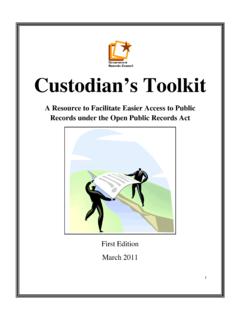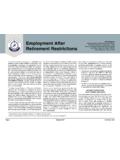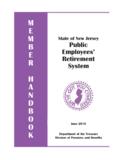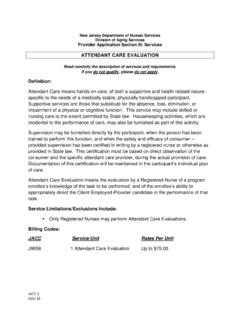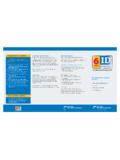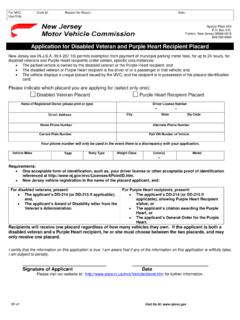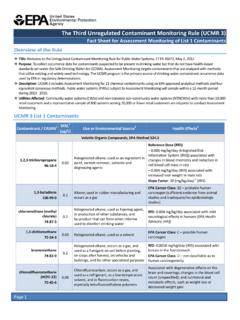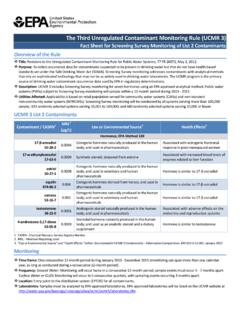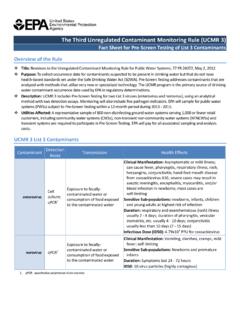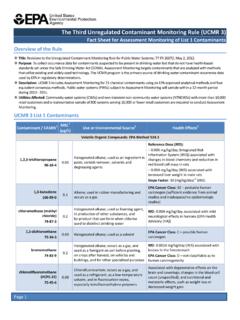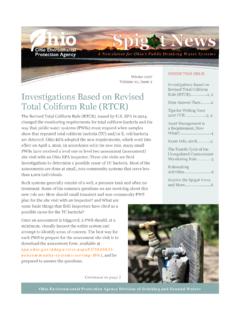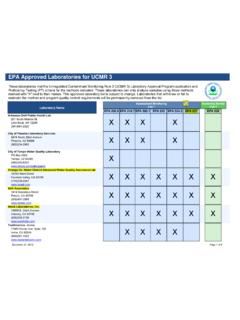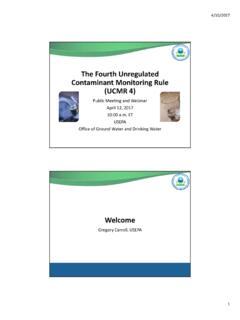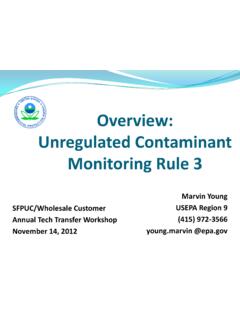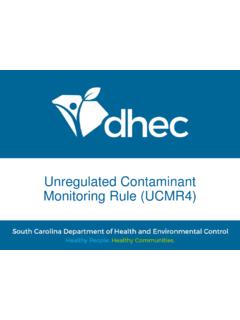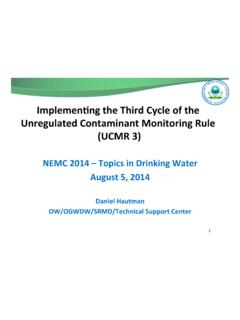Transcription of U.S. Environmental Protection Agency
1 Environmental Protection Agency New list of up to 30 unregulated contaminants every 5 years Public water systems > 10,000 must monitor 800 small systems nationwide Few very small systems for micro To provide baseline occurrence data that the USEPA can combine with toxicological research to make decisions about potential future drinking water regulations. 2 UCMR 1: 2001-2005 UCMR 2: 2008-2010 UCMR 3: 2013-2015 (Effective April 16, 2012) The USEPA, the states, laboratories and public water systems are all participating in the testing for UCMR3 in various ways. The Laboratory Approval Program requires laboratories to have USEPA approval to analyze samples for UCMR 3.
2 The data collected through the UCMR program are stored in National contaminant Occurrence Database for analysis and review of contaminant occurrence, guide the conduct of the contaminant Candidate List (CCL) process and support the regulatory decisions for contaminants in the interest of protecting public health, as required under SDWA Section 1412(b)(1). 3 General Flow of Federal Safe Drinking Water Act Regulatory Processes At each stage, need increased specificity and confidence in the type of supporting data used ( health, occurrence, treatment). Draft contaminant Candidate List Final CCL Final Rule (NPDWR) Six Year Review of Existing NPDWRs No further action if make decision to not to regulate (may develop health advisory).
3 Preliminary Regulatory Determinations Final Regulatory Determinations Proposed Rule (NPDWR) Public review and comment Draft unregulated contaminant monitoring Rule Final UCMR UCMR monitoring Results 4 5 monitoring Frequency by contaminant and Water Source Types contaminant type Water source type Time frame Frequency Chemical Surface water or ground water under the direct influence of surface water (GWUDI) 12 months 4 consecutive quarters 3 months apart. Ground water 12 months Twice in a consecutive 12-month period. 5-7 months apart. Microbiological Ground water 12 months Twice in a consecutive 12-month period. 5-7 months apart. UCMR periodically released data, June 2015 MRLs lower than in previous UCMRs Reference concentrations posted for most contaminants 831,908 data points nationwide 28,686 in New Jersey 14,673 first samples, remaining are repeat 7 Volatile Organic Compounds (7) 1,2,3-Trichloropropane 1,3-Butadiene Chloromethane (Methyl chloride) 1,1-Dichloroethane Bromomethane (Methyl bromide) Chlorodifluoromethane (HCFC-22) Bromochloromethane (Halon 1011) USEPA Method 8 Detected in UCMR3, not in NJ 1,3-Butadiene Choromethane Bromomethane Detected in UCMR3, not detected above ref.
4 Conc. in NJ 1,1-Dichloroethane* (54/1134 samples) Halon 1011 (5/1134; ref .conc. = 90 ug/L) HCFC-22 (12/1134; no reference concentration listed) Detected in UCMR3 in NJ above reference concentration 1,2,3-Trichloropropane Ref. conc. ug/L (10-6/10-4) Results range from - ug/L GW * NJ adopted a MCL for 1,1-dichloroethane of 50 ug/L in 1996. The UCMR3 results for 1,1-dichloroethane did not exceed the NJ MCL. 9 Synthetic Organic Compounds (1) 1,4-dioxane EPA Method 522 Oxyhalide Anion (1) Chlorate EPA , ASTM D6581-08, Standard Methods 4110D (1997) Metals (6) Vanadium Molybdenum Cobalt Strontium Chromium Hexavalent chromium EPA Rev , ASTM D5673-10, Standard Methods 3125 (1997) 10 1,4 - Dioxane Detected in UCMR3, in NJ above reference concentration Detected nationally (12% of samples) Detected in NJ (22% of samples) 57/1134 (5%) samples above reference conc.
5 (10-6) No results above 10-4 reference concentration Results ranged from ug/L Ref. conc. = ug/L (10-6/10-4) 11 Chlorate Detected in UCMR3, in NJ above reference concentration Detected nationally (56% samples) Detected in NJ (76% samples) MRL is 20 ug/L 237/1564 (15%) samples above reference conc. Ref. conc. = 210 ug/L Results ranged from 20 - 5756 ug/L 12 All Metals were detected in UCMR3 and in NJ UCMR3 Detected in UCMR3, not detected above ref. conc. in NJ Molybdenum 141/1566 (9%) of samples Range 1 20 ug/L (40 ug/L) Chromium 725/1563 (46%) of samples; MRL = ug/L Range - 58 ug/L (100 ug/L) Hexavalent Chromium 1086/1575 (69%) of samples.
6 MRL = ug/L Range ug/L (NA) Detected in UCMR3 in NJ above reference concentration Cobalt 121/1566 of samples (8%) 1 result > RC (70 ug/L) Range - 1097 ug/L Vanadium 475/1567 (30%) of samples 2 results > RC (21 ug/L) Range ug/L Strontium 1563/1566 (99+%) of samples Range 7756 ug/L (1500 ug/L) 13 Perfluorinated Compounds (6) perfluorooctane sulfonate (PFOS) perfluorooctanoic acid (PFOA) perfluorononanoic acid (PFNA) perfluorohexane sulfonic acid (PFHxS) perfluoroheptanoic acid (PFHpA) perfluorobutane sulfonic acid (PFBS) EPA 537 Rev 14 Detected in UCMR3, not in NJ PFBS Detected in UCMR3, not detected above ref.
7 Conc. in NJ PFOS ( 5 /1146 samples) ref. conc. = ug/L PFHpA (3/1146), no reference concentration available PFHxS (3/1146), no reference concentration available Detected in UCMR3 above reference concentration PFOA (60/1146 samples, 5%) Six samples above NJ guidance number ( ug/L) PFNA (6/1146 samples) Six samples above interim specific groundwater criteria ug/L 15 Hormones (7) 17- -estradiol 17- -ethynylestradiol (ethinyl estradiol) 16- -hydroxyestradiol (estriol) Equilin Estrone Testosterone 4-androstene-3,17-dione USEPA Method 539 16 Not Detected in UCMR3 Equilin Estrone Detected in UCMR3, not in NJ 17-beta estradiol 17-alpha-ethynylestradiol Estriol 4-androstene-3,17-dione Detected in UCMR3 in NJ Testosterone 1/215 samples ( ug/L) No reference concentration SW 17 List 3 Contaminants Enteroviruses Noroviruses USEPA Method 1615 Developed by USEPA and USGS E.
8 Coli Total coliform Aerobic spores Enterococcus Etc. 18 In NJ, some of UCMR3 contaminants were detected above reference concentrations UCMR data must be reported in the CCR 19
